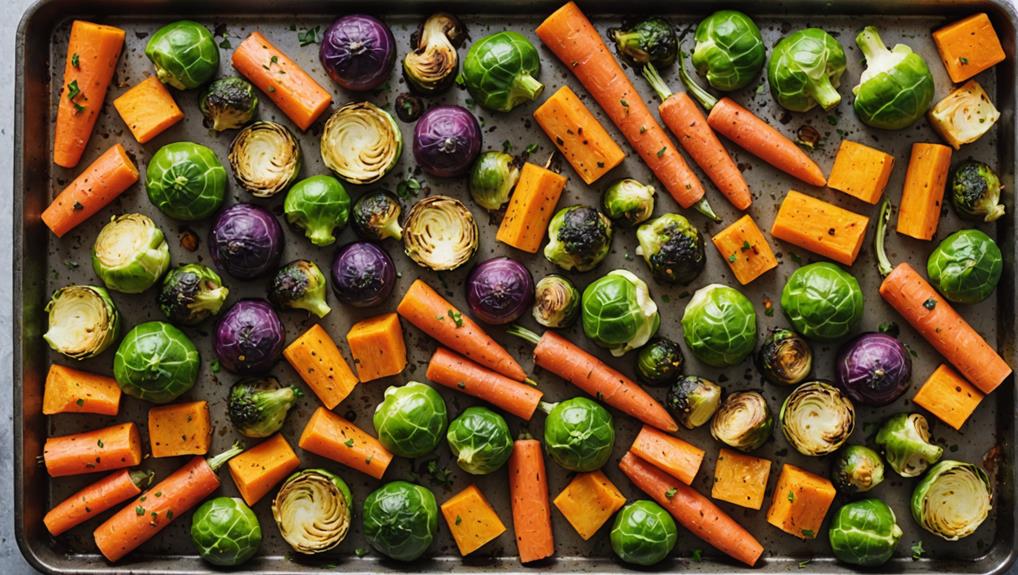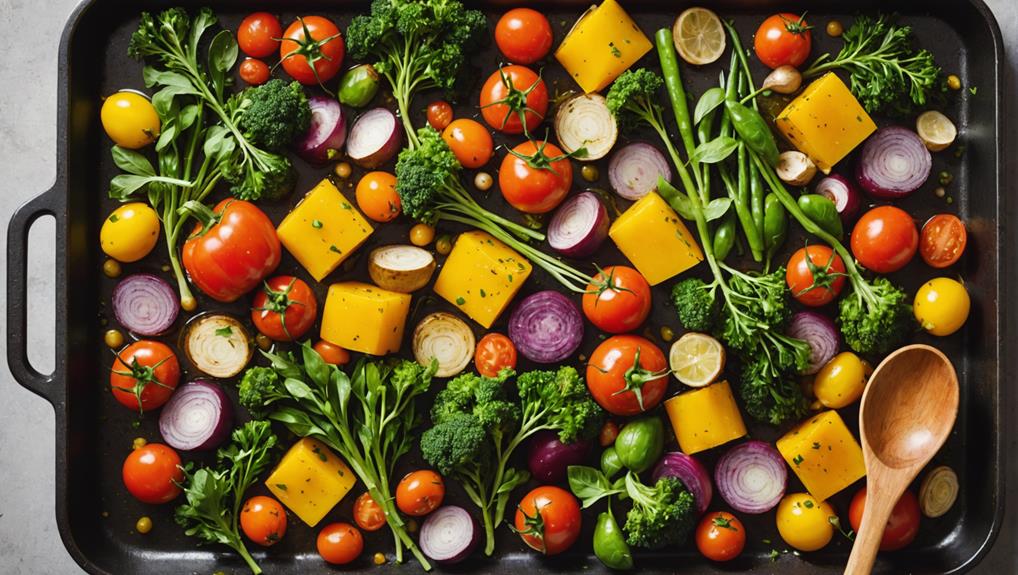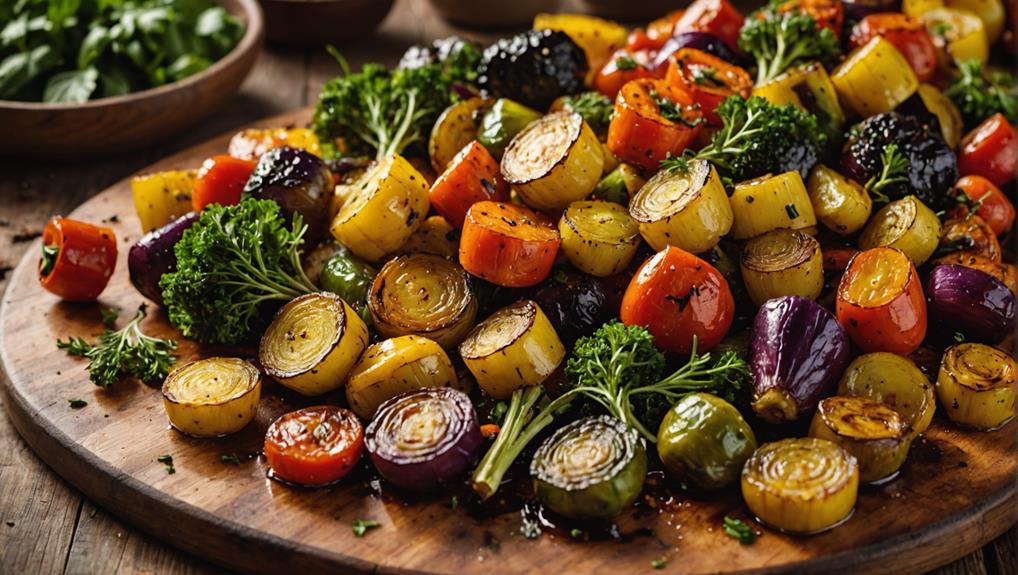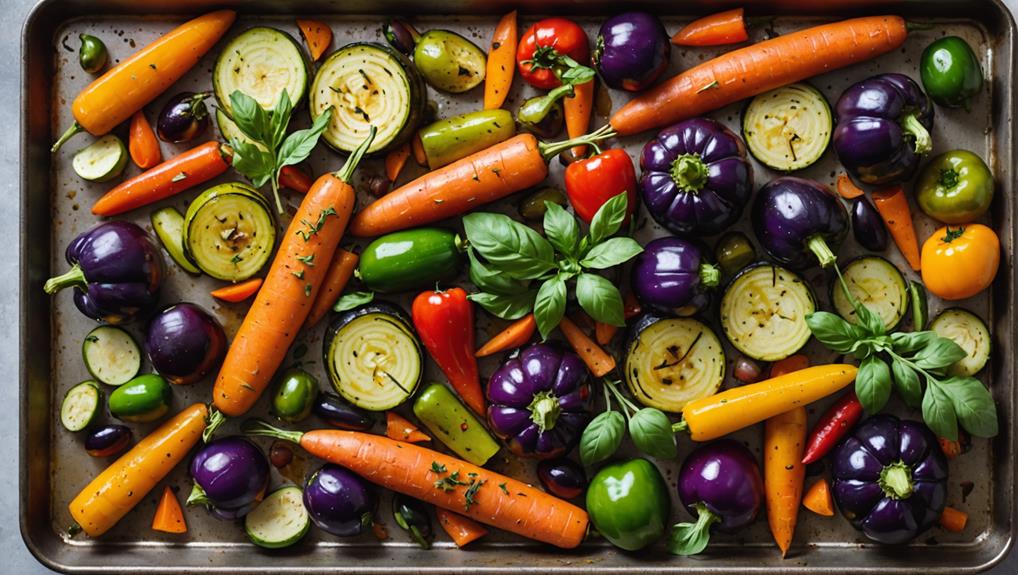To unlock the savory secrets of roasting veggies to perfection, start by prepping them properly. Cut your vegetables into uniform 1-inch pieces, pat them dry, and toss with olive oil, salt, and pepper. Choose a heavy-duty roasting pan that allows for a single layer, and preheat your oven to 400-450°F. Embrace high-heat techniques, flipping veggies halfway through for even browning. Experiment with seasonings like rosemary, thyme, or balsamic vinegar to enhance flavors. Don't forget to let your roasted veggies rest for 5-10 minutes before serving to redistribute juices and maintain crispiness. These techniques will elevate your vegetable game to new heights of deliciousness.
Prep Your Veggies Like a Pro
To kick off your veggie roasting journey, start with proper preparation. Mastering this crucial step will elevate your roasting technique and ensure perfectly caramelized results.
Begin by thoroughly washing your vegetables to remove any dirt or pesticides, ensuring a clean canvas for your culinary masterpiece. Next, unleash your inner chef by cutting the veggies into uniform sizes, around 1-inch pieces, which promotes even cooking and optimal caramelization. This professional touch not only improves texture throughout but also aligns with the recommended roasting technique for achieving that coveted golden-brown exterior.
To prep your veggies like a pro, pat them dry with a clean towel. This simple yet essential step eliminates excess moisture, paving the way for that crispy exterior.
Now, it's time to infuse flavor. Toss your veggies with olive oil, salt, and pepper as a base, then let your creativity shine by experimenting with herbs and spices, such as dried rosemary for a robust flavor profile maximize flavor development.
For maximum flavor development, allow your veggies to marinate for 15-30 minutes before roasting. This innovative approach gives the seasonings time to penetrate the vegetables, resulting in a more complex and satisfying taste profile.
With these preparation techniques mastered, you're well on your way to roasting veggies that will impress even the most discerning palates.
Selecting the Perfect Roasting Pan
With the right roasting pan, you'll elevate your veggie game to new heights. The key to unlocking savory perfection lies in selecting a pan that ensures even cooking and proper air circulation. Opt for a heavy-duty stainless steel or cast iron roasting pan, as these materials distribute heat evenly and stand the test of time.
Size matters when it comes to roasting vegetables. Choose a pan that accommodates your veggies in a single layer, preventing overcrowding and promoting optimal air flow. This crucial factor determines whether your vegetables roast to crispy perfection or steam into a lackluster mush.
While non-stick pans offer easy cleanup, consider traditional baking sheets for superior caramelization and flavor development.
A rimmed roasting pan is your best bet for containing juices and enhancing flavors, especially when you're experimenting with marinades or seasonings. Don't overlook the importance of oven-safe handles – they're essential for effortlessly maneuvering your pan mid-roast, allowing you to redistribute vegetables for uniform cooking.
Seasoning Strategies for Maximum Flavor

Now that you've selected the perfect roasting pan, it's time to focus on seasoning your vegetables. The key to perfectly roasted vegetables lies in your seasoning strategies. Start with a foundation of olive oil, salt, and pepper to enhance natural flavors and promote caramelization.
For innovative flavor combinations, experiment with:
- Rosemary and thyme for a classic herb profile
- Cumin and paprika for a warm, smoky taste
- Balsamic vinegar or lemon juice for a tangy kick
- Parmesan or halloumi cheese for savory richness
Incorporating seasonal vegetables, like those found in dishes such as honey mustard chicken thighs with spring vegetables, can further enhance your roasting experience.
To elevate your seasoning game, try marinating your veggies in a mixture of olive oil, garlic, and herbs for 15-30 minutes before roasting. This technique infuses deeper flavors, transforming ordinary vegetables into extraordinary side dishes.
As you roast, don't be afraid to layer flavors. Start with your base seasoning, then add herbs or spices midway through cooking. Finally, introduce cheese or a splash of acidity in the last few minutes for a burst of flavor that'll have your taste buds dancing.
With these seasoning strategies, you'll unlock the full potential of your roasted vegetables, creating dishes that are both innovative and irresistible.
Embrace the High-Heat Technique
To maximize caramelization and achieve that perfect tender-crisp texture, you'll want to embrace high-heat roasting techniques for your vegetables.
Set your oven between 400°F and 450°F, the temperature sweet spot that brings out natural sugars and develops rich flavors.
For optimal results, position your oven rack in the middle or lower third of the oven, ensuring even heat distribution and promoting that desirable crispy exterior.
Maximizing Caramelization
Caramelization is the key to unlocking the most delicious flavors in your roasted vegetables. To maximize caramelization and achieve perfectly tender, naturally sweet veggies, you'll need to master a few crucial techniques.
Start by cranking up your oven to between 400°F and 450°F, creating the ideal environment for those sugars to develop. The high heat will also help achieve that coveted crispy exterior while keeping the insides tender, much like in the preparation of Maple Glazed Brussels Sprouts.
Ensure your vegetables are cut uniformly and patted dry before roasting to promote even cooking and crispiness.
To take your roasting game to the next level:
- Spread vegetables in a single layer on your baking sheet
- Keep the oven door closed to maintain high heat
- Cut vegetables into consistent sizes for uniform cooking
- Pat vegetables dry to prevent steaming and enhance crispness
Temperature Sweet Spot
The temperature sweet spot is where the magic happens in roasting vegetables. To unlock the savory secrets of perfectly roasted veggies, you'll want to embrace the high-heat technique. Set your oven between 400°F and 450°F, as this range is the perfect companion for caramelizing the natural sugars in your vegetables. This process results in deep flavors and crispy textures that'll revolutionize your culinary creations.
Before you start roasting, preheat your oven to ensure it reaches the desired temperature quickly. This step is crucial for even cooking and avoiding unwanted steaming.
Most vegetables require 20-30 minutes of roasting time, but keep a close eye on them to achieve that ideal tender-yet-crispy texture. To maximize the high-heat technique, arrange your veggies in a single layer on the baking sheet. This allows proper air circulation, ensuring they roast rather than steam.
For optimal flavor and texture development, flip or redistribute your vegetables halfway through cooking. This simple action promotes even browning and enhances caramelization, resulting in mouth-watering, perfectly roasted veggies every time.
Oven Rack Positioning
Mastering oven rack positioning is crucial when embracing the high-heat technique for roasting vegetables. For optimal results, position your rack in the upper third of the oven. This strategic placement allows for:
- Enhanced air circulation
- Better heat exposure
- Crisp edges and tender interiors
- Faster cooking times
By utilizing the upper rack, you're revolutionizing your cooking method. The higher position intensifies the heat, typically around 400°F to 450°F, promoting caramelization and creating that irresistible roasted flavor.
Keep in mind that this technique may require adjusting your usual cooking time, as vegetables often roast faster in this position.
To maximize the benefits of this high-heat approach, keep the oven door closed throughout the process. This maintains consistent temperature, crucial for achieving the perfect texture without unwanted steaming.
If you're using multiple trays, don't forget to rotate them halfway through cooking. This ensures even browning and prevents overcooking on one side.
The Art of Mid-Roast Tossing

To achieve perfectly roasted vegetables, you'll need to master the art of mid-roast tossing, which ensures even caramelization and prevents sticking.
By gently redistributing your veggies halfway through cooking, you're promoting consistent browning on all sides while maximizing their exposure to heat.
This technique not only enhances flavor but also helps you avoid the frustration of vegetables that are unevenly cooked or stuck to the baking sheet.
Ensuring Even Caramelization
For perfect caramelization, mid-roast tossing is essential. This crucial step in roasting vegetables ensures even cooking and browning throughout, elevating your dish to new heights of flavor and texture.
By redistributing the vegetables halfway through the cooking process, you're exposing all sides to the heat, creating a consistent caramelization that'll tantalize your taste buds.
To achieve optimal results, follow these innovative tips:
- Use a high-quality baking sheet for superior heat distribution
- Spread vegetables in a single layer, avoiding overcrowding
- Toss at the 10-15 minute mark, depending on cooking time and vegetable size
- Monitor closely and adjust roasting time based on vegetable type and size
Preventing Vegetable Sticking
The art of mid-roast tossing isn't just about even cooking; it's crucial for preventing vegetable sticking. As you embark on your roasted vegetables journey, remember that proper technique can transform your dish from mediocre to magnificent.
Start by ensuring your veggies are bone-dry before they hit the pan; excess moisture is the enemy of crispy, caramelized perfection. Don't skimp on the olive oil—it's your ally in preventing vegetable sticking and enhancing flavor. Coat your vegetables thoroughly, creating a protective barrier between them and the baking sheet.
Speaking of baking sheets, invest in a high-quality one or line it with parchment paper for effortless flipping. Resist the urge to overcrowd; give your veggies room to breathe in a single layer. If necessary, use two pans to maintain optimal air circulation.
As your vegetables roast, perform the crucial mid-roast toss. This redistributes them, preventing uneven cooking and sticking while promoting consistent caramelization.
Broiling for Irresistible Crispiness
Broiling offers a game-changing technique for achieving irresistibly crispy veggies in record time. This high-heat method harnesses direct heat from above, revolutionizing your roasting vegetables routine. By tossing your veggies with olive oil and seasonings before broiling, you'll unlock a depth of flavor that traditional roasting can't match.
To master this innovative approach, follow these key steps:
- Spread vegetables in a single layer on a baking sheet
- Flip them halfway through for even cooking
- Experiment with cheese like halloumi for added richness
- Keep a close eye on the process to prevent burning
Broiling not only speeds up cooking time but also elevates the natural sweetness of vegetables through the Maillard reaction. This scientific process creates a complex flavor profile that'll tantalize your taste buds.
You'll notice the difference in vegetables like butternut squash and bell peppers, which develop a crispy exterior while maintaining a tender interior.
Resting: The Final Flavor Boost

Roasted vegetables' journey to perfection doesn't end when you remove them from the oven. In fact, the final step in achieving culinary excellence lies in the art of resting. By allowing your roasted veggies to rest for 5 to 10 minutes post-cooking, you'll unlock a world of flavor improvements that will elevate your dish to new heights.
During this crucial resting period, internal juices redistribute throughout the vegetables, enhancing their overall taste and mouthfeel. You'll notice a remarkable difference in the caramelization on the surface, creating an even more appealing appearance.
This brief pause also prevents steam buildup, ensuring your veggies maintain their coveted crispy texture rather than turning soggy.
But the benefits don't stop there. Resting your roasted veggies not only amplifies their flavor profile but also allows for a more visually stunning presentation. As they settle, their colors become more vibrant, making them irresistibly enticing on the plate.
Creative Serving and Pairing Ideas
From out of the oven and onto the plate, your perfectly roasted veggies are ready to shine with creative serving and pairing ideas. Elevate your roasted vegetables' flavor presentation by drizzling balsamic glaze over butternut squash and sweet potatoes, enhancing their natural sweetness with a tantalizing sweet-and-sour profile.
For a vibrant twist, combine roasted bell peppers and zucchini with fresh herbs like basil or thyme, taking your dish to new heights.
Transform your roasted vegetables into a complete meal by pairing them with complementary proteins and garnishes. Consider these innovative combinations:
- Serve roasted broccoli or cauliflower alongside grilled salmon and lemon wedges
- Toss a colorful mix of roasted carrots, beets, and parsnips with toasted pumpkin seeds
- Sprinkle feta or Parmesan cheese over your roasted veggies for added richness
- Pair roasted sweet potatoes with a dollop of Greek yogurt and a sprinkle of za'atar
Frequently Asked Questions
What Is the Secret to Roasting Vegetables?
To master roasting vegetables, you'll want to focus on innovative roasting techniques, experiment with unique seasoning blends, and nail the ideal temperatures. Don't be afraid to push boundaries and try unconventional flavor combinations for truly remarkable results.
How Roasting Vegetables Brings Out the Savory Sweetness in the Food?
When you roast veggies, you're unlocking their hidden potential. The caramelization process transforms texture and enhances flavor, turning natural sugars into complex, savory-sweet notes. It's a game-changing technique that'll revolutionize your veggie game.
How to Get Crunchy Roasted Veggies?
To get crunchy roasted veggies, you'll want to master innovative roasting techniques. Experiment with seasoned toppings, adjust cooking times, and ensure proper drying. Don't forget to flip midway and use high heat for that perfect, crispy exterior you're craving.
What Vegetables Are Best for Roasting?
You're not a rabbit, so ditch the raw carrot sticks! Embrace colorful combinations like cruciferous veggies, root vegetables, and alliums. Experiment with seasoning techniques and optimal temperatures to transform ordinary produce into roasted masterpieces. You'll revolutionize your veggie game!
Final Thoughts
You've now mastered the art of roasting vegetables to perfection. By following these techniques, you'll transform ordinary produce into culinary masterpieces. Did you know that roasting can increase the antioxidant content in certain vegetables by up to 40%? This not only enhances flavor but also boosts nutritional value. So, fire up your oven, experiment with different veggie combinations, and enjoy the delicious results of your newfound roasting expertise. Your taste buds, and your health, will thank you.













